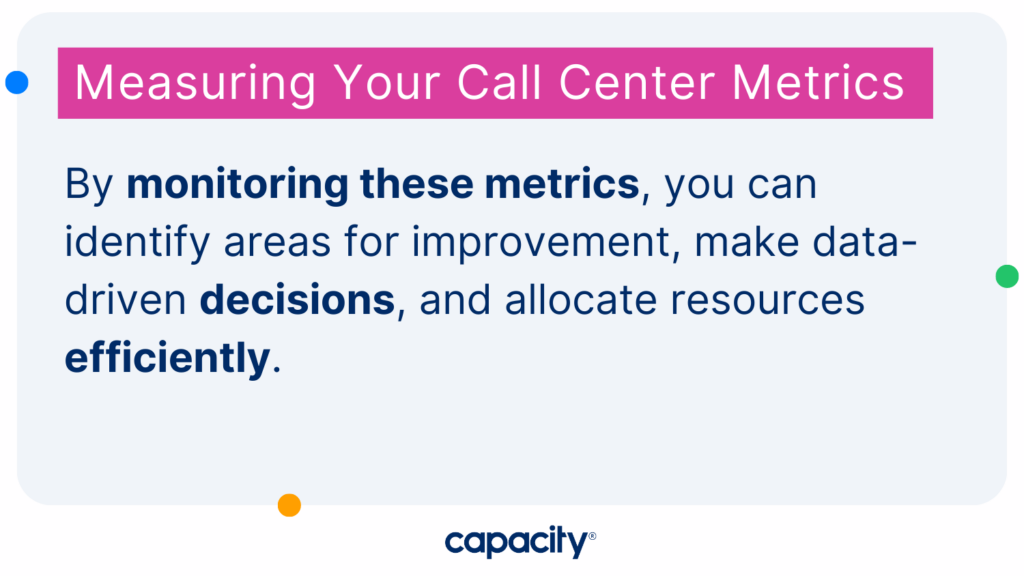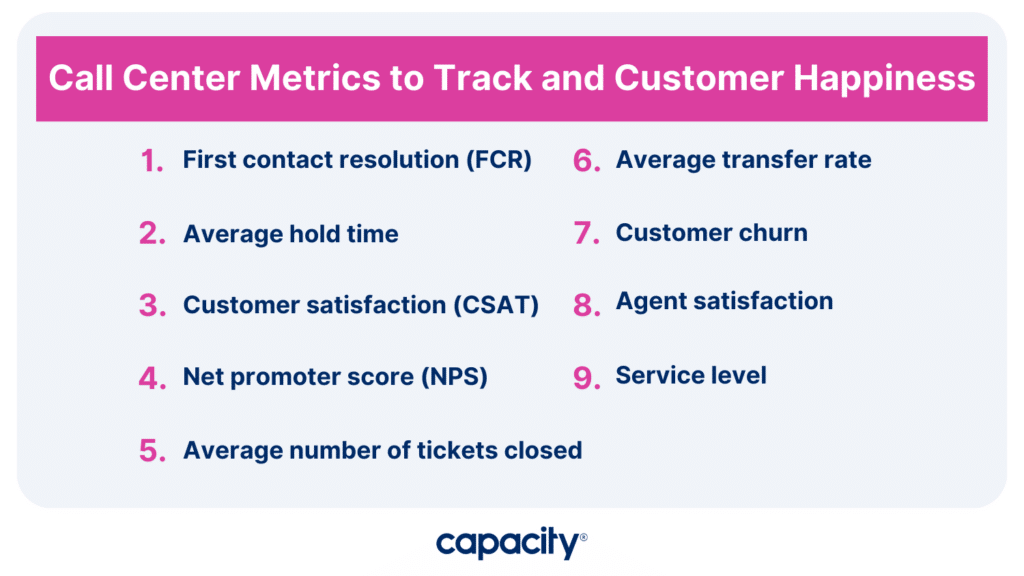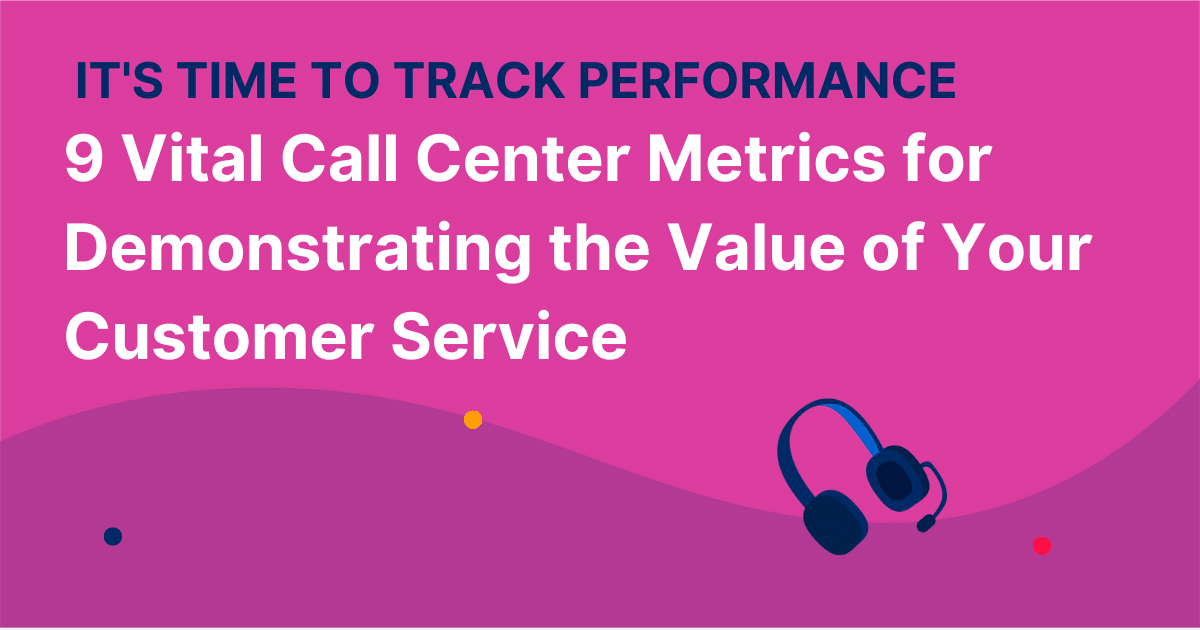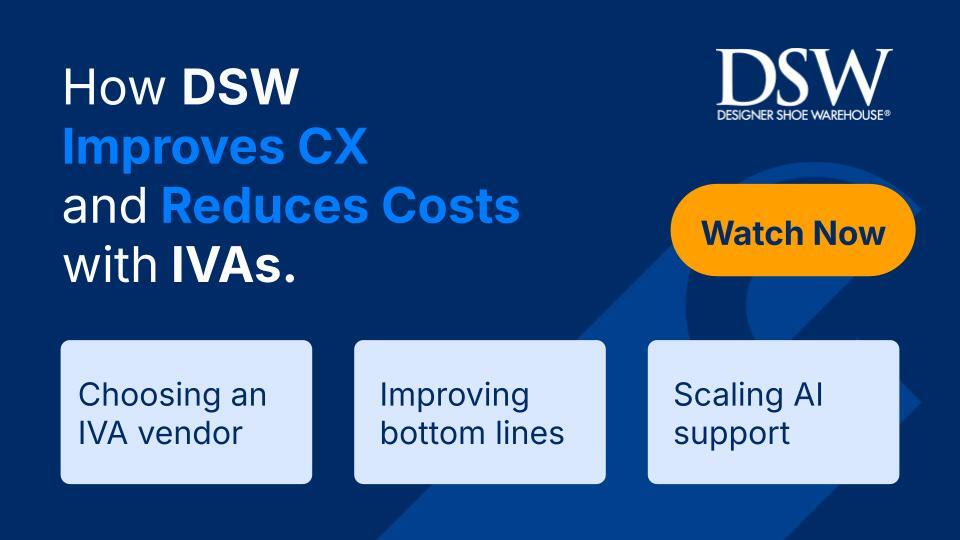Providing exceptional customer service is crucial for maintaining customer satisfaction and loyalty. In fact, business that prioritize their customer experience grow their revenue 1.7 times faster than businesses that don’t. According to Adobe, 66% of businesses that prioritize customer experience see increased retention and 60% see an increase in customer lifetime value. One effective way to achieve these goals is by tracking key call center metrics. In this article, we will explore nine essential call center metrics that will help you measure performance, enhance customer happiness, and drive the success of your customer service team.
Why you should be measuring your call center metrics

Call center metrics provide valuable insights into the overall performance and effectiveness of your customer service operations. By monitoring these metrics, you can identify areas for improvement, make data-driven decisions, and allocate resources efficiently. Additionally, tracking call center metrics allow you to measure the impact of any changes or initiatives you implement, ensuring continuous growth and success.
9 call center metrics to track value, performance, and customer happiness

1. First contact resolution (FCR)
Firstly, FCR refers to the percentage of customer inquiries or issues resolved during the initial contact with a customer service representative. It measures the efficiency and effectiveness of your agents in addressing customer needs promptly. High FCR rates indicate that your team possesses the skills and knowledge to resolve customer issues efficiently, leading to improved customer satisfaction and reduced operational costs.
2. Average hold time
Average Hold Time is the average duration your customers spend on hold while waiting to connect with a customer service representative. It is a critical metric for measuring customer experience and satisfaction. Minimizing hold times ensures that customers receive timely assistance, reducing frustration and increasing overall satisfaction levels.
3. Customer satisfaction (CSAT)
CSAT is a popular metric to measure customer happiness based on their interaction and experience with your customer service team. Most often, you can find your CSAT through post-interaction surveys or feedback forms. By tracking CSAT scores, you can gauge the effectiveness of your team’s service delivery and identify areas where improvements are needed to enhance customer satisfaction.
4. Net promoter score (NPS)
NPS is a metric that assesses customer loyalty and their likelihood to recommend your company to others. In summary, NPS is measured through a single question: “On a scale of 0-10, how likely are you to recommend our company to a friend or colleague?” In effect, NPS categorizes customers as promoters, passives, or detractors, providing insights into your customer base’s overall sentiment and loyalty.
5. Average number of tickets closed
This metric measures the average number of support tickets resolved by your customer service team within a specific time frame. Basically, it reflects the team’s productivity and efficiency in resolving customer issues. Increasing this metric indicates that your team can handle more inquiries, resulting in faster response times and improved customer satisfaction.
6. Average transfer rate
The Average Transfer Rate measures the frequency at which customer inquiries are transferred from one agent or department to another. A high transfer rate can negatively impact customer experience, causing frustration and delays in issue resolution. But by minimizing unnecessary transfers, you can streamline your support process and provide more seamless customer interactions.
7. Customer churn
Customer churn represents the rate at which customers stop using your products or services. While it may not be directly tied to call center performance, tracking customer churn can help you identify potential issues that might contribute to customer dissatisfaction. By addressing these issues promptly, you can reduce churn and retain valuable customers.
8. Agent satisfaction
Agent Satisfaction is a metric that focuses on measuring the happiness and engagement levels of your customer service team. Satisfied and motivated agents are more likely to provide exceptional customer service and deliver positive experiences. By regularly measuring agent satisfaction, you can identify areas where for improvements. This then lets you boost employee retention and overall team performance.
9. Service level
Lastly, service level. Your service level measures the percentage of customer calls answered within a specified time frame, typically expressed as a percentage. It reflects the responsiveness and efficiency of your call center in handling incoming customer calls. Maintaining a high service level ensures that customers receive prompt assistance and reduces the likelihood of abandonment or dissatisfaction.
By consistently monitoring and analyzing these call center metrics, you can gain valuable insights into your team’s performance, identify areas for improvement, and demonstrate the value of your customer service efforts to key stakeholders and company leadership.
As a customer service manager or professional in customer operations, tracking call center metrics is essential for driving success and delivering exceptional customer service. The nine vital call center metrics discussed in this article provide a comprehensive view of your team’s performance, customer satisfaction levels, and overall value. By using these metrics effectively, you can make data-driven decisions, continuously improve your operations, and enhance the customer experience.
Track and analyze insights inside your helpdesk for success. Capacity can help. Try it for free today, or request a personalized demo!

Automate Your Work
Capacity’s enterprise AI chatbot can help:
- Answer FAQs anytime, anywhere
- Find relevant documents within seconds
- Give surveys and collect feedback












































